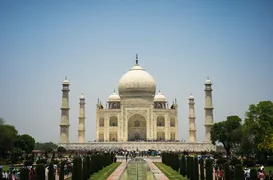Taj Mahal

The best of Taj Mahal
Bucket-list experiences
Make it a getaway
More to explore
Nearby places to go
FAQs about Taj Mahal
When is the best time to visit the Taj Mahal?
How can I get to Agra to visit the Taj Mahal?
Are there any important travel tips for visiting the Taj Mahal?
What are the visiting hours for the Taj Mahal?
What local transportation options are available in Agra?
What should I know about entry and regulations at the Taj Mahal?
What to know before visiting Taj Mahal
Remarkable Landmarks and Must-Visit Sights
Taj Mahal
The Taj Mahal is a stunning white marble mausoleum that stands as a testament to eternal love. Built over 22 years with the labor of 22,000 workers and 1,000 elephants, this architectural marvel features intricate designs inlaid with semi-precious stones. Visitors can explore the main gateway, the square garden, the red sandstone mosque, and the jawab (mirror) building.
Oberoi Amarvilas
Located just 2,000 feet from the Taj Mahal, the Oberoi Amarvilas offers luxurious accommodations with stunning views of the monument from every room. The resort features nine acres of terraced gardens, pools, and pavilions, making it a tranquil retreat. The Kohinoor Presidential Suite provides the ultimate VIP experience with its private terrace and personal butler service.
Mehtab Bagh
While many tourists visit Mehtab Bagh for a sunset view of the Taj Mahal, it is recommended to experience the monument from the main entrance for the ultimate wow factor. This site across the river offers a different perspective but can be crowded and less majestic.
Cultural and Historical Significance
The Taj Mahal is a UNESCO World Heritage Site and one of the New 7 Wonders of the World. Built between 1631 and 1653, it symbolizes the rich history and cultural heritage of the Mughal Empire. The mausoleum was constructed by over 20,000 artisans under the guidance of Ustad Ahmad Lahori, the emperor's court architect.
Architectural Style
The Taj Mahal is a prime example of Mughal architecture, which combines elements of Islamic, Persian, Ottoman Turkish, and Indian architectural styles. The use of white marble, symmetrical design, and intricate inlays are hallmarks of this style.
Local Cuisine
Visitors to Agra can indulge in the local cuisine, which includes delicacies like Petha (a sweet made from ash gourd), Mughlai dishes such as kebabs and biryanis, and a variety of street foods. Dining in Agra offers a unique blend of flavors that reflect the city's rich culinary heritage.
Culture and History
The Taj Mahal is not just a monument but a symbol of India's rich cultural and historical heritage. Built during the reign of Shah Jahan, a period of prosperity and stability, the Taj Mahal reflects the opulence of the Mughal era. The story of its construction is filled with drama and emotion, from the promise Shah Jahan made to his dying wife to the eventual imprisonment by his son Aurangzeb.
Local Cuisine
Agra offers a variety of local dishes that are a must-try for any visitor. From the famous Agra petha (a sweet made from ash gourd) to savory delights like Mughlai cuisine, the city's culinary offerings are as rich and diverse as its history. Dining experiences at the Oberoi Amarvilas, such as a poolside dinner under the stars, add a touch of luxury to your culinary journey.



